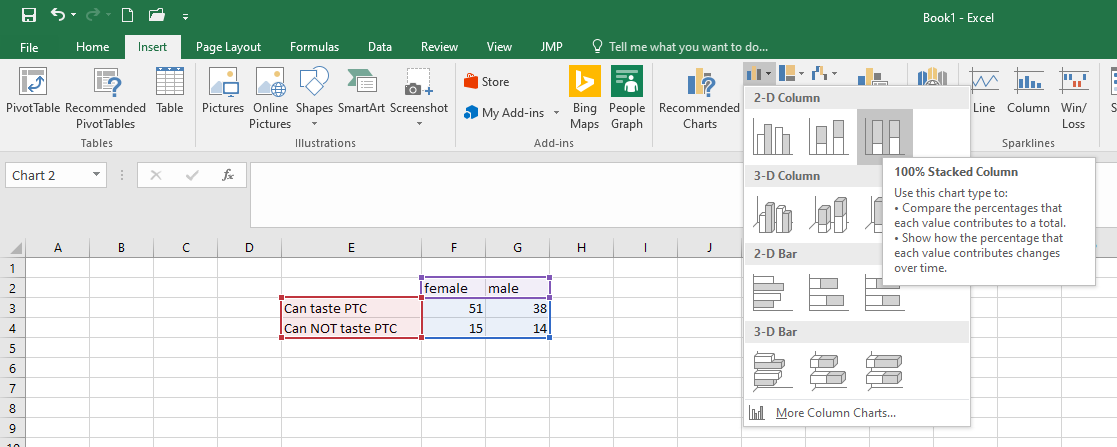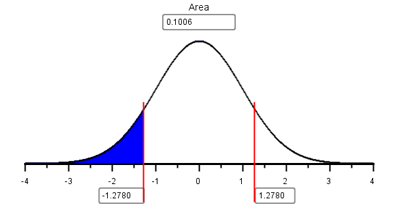Lesson 18: Inference for Two Proportions
Optional Videos for this Lesson
Part 1
Part 2
Part 3
Part 4
Part 5
Lesson Outcomes
By the end of this lesson, you should be able to do the following.
- Recognize when a difference of two proportions inferential procedure is appropriate
- Create numerical and graphical summaries of the data
- Perform a hypothesis test for the difference of two proportions
using the following steps:
- State the null and alternative hypotheses
- Calculate the test-statistic and P-value of the test using software
- Assess statistical significance in order to state the appropriate conclusion for the hypothesis test
- Check the requirements for the hypothesis test
- Create a confidence interval for the difference of two proportions
using the following steps:
- Calculate a confidence interval using software
- Interpret the confidence interval
- Check the requirements of the confidence interval
Hypothesis Tests

Another Taste of PTC

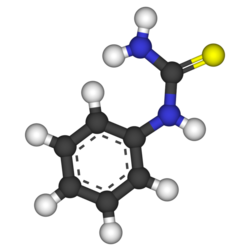
The ability to taste the chemical Phenylthiocarbamide (PTC) is hereditary. Some people can taste it, while others cannot. Even though the ability to taste PTC was observed in all age, race, and sex groups, this does not address the issue about whether men or women are more likely to be able taste PTC.
Further exploration of the PTC data allows us to investigate if there is a difference in the proportion of men and women who can taste PTC. The following contingency table summarizes Elise Johnson’s results:
| Can Taste PTC? | Female | Male | Total |
|---|---|---|---|
| No | 15 | 14 | 29 |
| Yes | 51 | 38 | 89 |
| Total | 66 | 52 | 118 |
These data are available in the file PTCTasting. Note the way the data are organized in the file. One column gives the gender, another column indicates if the individual can taste PTC, and a third column gives counts for each group.
Researchers want to know if the ability to taste PTC is a sex-linked trait. This can be summarized in the following research question: Is there a difference in the proportion of men and the proportion of women who can taste PTC? The hypothesis is that there is no difference in the the true proportion of men who can taste PTC compared to the true proportion of women who can taste PTC.

A sample of 66 females and 52 males were provided with PTC strips and asked to indicate if they could taste the chemical or not. (This research was approved by the BYU-Idaho Institutional Review Board.)

When working with categorical data, it is natural to summarize the data by computing proportions. If someone has the ability to taste PTC, we will call this a success. The sample proportion is defined as the number of successes observed divided by the total number of observations. For the females, the proportion of the sample who could taste the PTC was: \[ \hat p_1 = \frac{x_1}{n_1} = \frac{51}{66} \] This is approximately 77.3% of the people who were surveyed. For the males, the proportion who could taste PTC was: \[ \hat p_2 = \frac{x_2}{n_2} = \frac{38}{52} \] This works out to be about 73.1%.
When working with data for two proportions, graphically displaying the data can help us compare each proportion. Pie charts and bar charts are essential tools for describing our data. The Math221 Statistics Toolbox automatically creates a side-by-side 100% stacked bar chart when you input the data into the “Two Proportions” tab.

The null and alternative hypotheses for a test of equality of two proportions is: \[ \begin{array}{rl} H_0: & p_1 = p_2 \\ H_a: & p_1 \ne p_2 \\ \end{array} \]
If the null hypothesis is true, then the proportion of females who can taste PTC is the same as the proportion of males who can taste PTC.
The test statistic is a \(z\), and is given by: \[ z = \frac{ \left( \hat p_1 - \hat p_2 \right) - \left( p_1 - p_2 \right) }{ \sqrt{\hat p \left( 1-\hat p \right) \left( \frac{1}{n_1} + \frac{1}{n_2} \right) } } \] where \[ \begin{array}{lll} n_1= \text{sample size for group 1:} & n_1 = 66 & \text{(number of females)} \\ n_2= \text{sample size for group 2:} & n_2 = 52 & \text{(number of males)} \\ \hat p_1= \text{sample proportion for group 1:} & \hat p_1 = \frac{x_1}{n_1} = \frac{51}{66} & \text{(proportion of females who can taste PTC)}\\ \hat p_2= \text{sample proportion for group 2:} ~ & \hat p_2 = \frac{x_2}{n_2} = \frac{38}{52} & \text{(proportion of males who can taste PTC)}\\ \hat p= \text{overall sample proportion:} & \hat p = \frac{x_1+x_2}{n_1+n_2} = \frac{89}{118} & \text{(overall proportion who can taste PTC)}\\ \end{array} \]
Substituting these values into the equation for the test statistic, \(z\), we get: \[ \begin{align} z & = \frac{ \left( \hat p_1 - \hat p_2 \right) - \left( p_1 - p_2 \right) }{ \sqrt{\hat p \left( 1-\hat p \right) \left( \frac{1}{n_1} + \frac{1}{n_2} \right) } } \\ & = \frac{ \left( \hat p_1 - \hat p_2 \right) - \left( 0 \right) }{ \sqrt{\hat p \left( 1-\hat p \right) \left( \frac{1}{n_1} + \frac{1}{n_2} \right) } } \\ & ~ ~ ~ ~ ~ \textrm{In the null hypothesis, we assumed that} ~ p_1=p_2. \\ & ~ ~ ~ ~ ~ \textrm{Or after subtracting,} ~ p_1-p_2=0 \\ & ~ ~ ~ ~ ~ \textrm{So, we substituted} ~ 0 ~ \textrm{for} ~ p_1-p_2 ~ \text{in the previous step.} \\ & = \frac{ \left( \frac{51}{66} - \frac{38}{52} \right) - (0) }{ \sqrt{\frac{89}{118} \left( 1-\frac{89}{118} \right) \left( \frac{1}{66} + \frac{1}{52} \right) } } \\ & = 0.526 \\ \end{align} \]
The test statistic is \(z=0.526\). Under the null hypothesis, this follows a standard normal distribution. So, we can use the Normal Probability applet to compute the \(P\)-value. We are conducting a two-sided test, so we will shade both tails in the applet.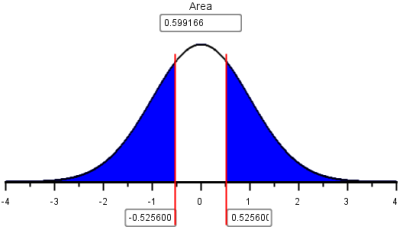
Since \(P\textrm{-value} = 0.599 > 0.05 = \alpha\), we fail to reject the null hypothesis. In English we say, there is insufficient evidence to suggest that the true proportion of males who can taste PTC is different from the true proportion of females who can taste PTC.

Men and women appear to be able to taste PTC in equal proportions. There is not enough evidence to say that one gender is able to taste PTC more than the other. It appears that the ability to taste PTC is not a sex-linked trait.
Using Excel to perform these calculations
Just like we did for one proportion, we will use the Math 221 Statistics Toolbox to perform hypothesis tests for two proportions.
Click on the link at right for instructions on using this spreadsheet to perform hypothesis testing. Show/Hide Instructions
Mortality Rates and Day of Admission: Aortic Aneurysms
Some people have claimed that mortality (death) rates are higher for patients admitted to a hospital on a weekend compared to patients admitted on a weekday. Researchers Chaim Bell and Donald Redelmeier analyzed admission data from hospital emergency rooms in Ontario, Canada .
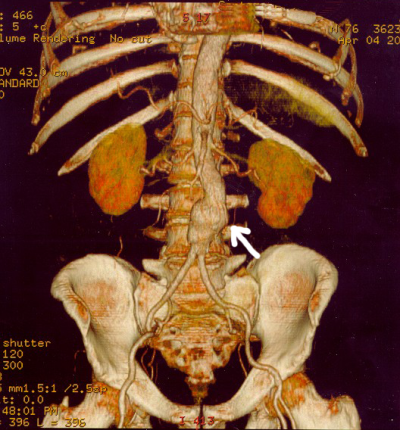
The aorta is a major artery that takes oxygen-rich blood from the heart to the entire body. In some patients, this artery can swell like a balloon and burst. If this occurs in the abdomen, the technical term for the event is a ruptured abdominal aortic aneurysm. Although this condition is treatable, it requires immediate action, or the patient will die rapidly.

The problem is that the quality of care in an emergency care facility may differ at different times of the week. Doctors Bell and Redelmeier hypothesized that the probability that a patient with an aortic aneurysm will die is greater if they are admitted to a hospital on a weekend compared to a weekday.
Hypothesis: The proportion of patients with a ruptured abdominal aortic aneurysm who will die is greater on the weekends than on weekdays.

To test this claim, the researchers accessed medical records for several patients admitted to the emergency department of the hospitals in Ontario, Canada. They recorded the number of patients admitted with an aortic aneurysm on weekdays compared to weekends.
Data representative of their results are given below .
| Outcome | Weekday Admission | Weekend Admission |
|---|---|---|
| Died (x) | \(x_1 = 1476\) | \(x_2 = 553\) |
| Survived | \(2669\) | \(756\) |
| Total (n) | \(n_1 = 4145\) | \(n_2 = 1309\) |

- Use the data above to find the estimated proportion of patients admitted with an aortic aneurysm on a weekday who will die, \(\hat p_1\).
- Use the data to compute the estimated proportion of the patients admitted on a weekend that will die, \(\hat p_2\).
- What do you notice about \(\hat p_1\) and \(\hat p_2\)?
- Without doing any more calculations, do you think that there is a significant increase in the death rates of patients admitted on a weekend compared to those admitted on a weekday? Justify your answer.

–> –>

We now conduct a formal hypothesis test to determine if the mortality (death) rate is greater on a weekend compared to a weekday. First, we state the null and alternative hypotheses: \[ \begin{align} H_0: & p_1 = p_2 \\ H_a: & p_1 < p_2 \end{align} \] where group 1 represents the patients admitted on a weekday and group 2 represents patients admitted on a weekend. Note that if \(p_1 < p_2\), then the risk of death is greater in group 2 than in group 1. We will use the 0.05 level of significance.
Checking Requirements for the Hypothesis Test
If the sample size is large in both groups, then we can use the normal distribution to compute the \(P\)-value. To check if the sample size is large enough, we need to check the following requirements: \[ \begin{array}{rrr} n_1 \cdot \hat p_1 \ge 10 && n_2 \cdot \hat p_2 \ge 10 \\ n_1 \cdot \left(1-\hat p_1\right) \ge 10 && n_2 \cdot \left(1-\hat p_2\right) \ge 10 \end{array} \] If these requirements are satisfied, the \(z\)-statistic can be used to compute to assess whether the true population proportions are equal or if the risk of death is greater on weekends.
Note that the requirements are all satisfied: \[ \begin{array}{rr} n_1 \cdot \hat p_1 = 4145 \cdot 0.3561 = 1476 \ge 10 & n_2 \cdot \hat p_2 = 1309 \cdot 0.4225 = 553 \ge 10 \\ n_1 \cdot \left(1-\hat p_1\right) = 4145 \cdot 0.6439 = 2669 \ge 10 & n_2 \cdot \left(1-\hat p_2\right) = 1309 \cdot 0.5775 = 756 \ge 10 \end{array} \]
Reminder: \(~ x_1 = 1476,~x_2 =553\), \(n_1=4145,~n_2 = 1309\), \(\hat p_1 = \frac{x_1}{n_1},~\hat p_2 = \frac{x_2}{n_2}\), and \(\hat p = \frac{x_1+x_2}{n_1+n_2}\).
The test statistic can be computed by following these steps:
- First, find the combined proportion of “successes.” This is computed as: \[ \hat p = \frac{x_1+x_2}{n_1+n_2} = \frac{1476+553}{4145+1309} = \frac{2029}{5454} \]
- Next, enter the appropriate values into the equation for the \(z\)-score. \[ \begin{array}{rcll} z &=& \frac{ \left( \hat p_1 - \hat p_2 \right) - \left( p_1 - p_2 \right) }{ \sqrt{\hat p \left( 1-\hat p \right) \left( \frac{1}{n_1} + \frac{1}{n_2} \right) } } \\ &=& \frac{ \left( \hat p_1 - \hat p_2 \right) - \left( 0 \right) }{ \sqrt{\hat p \left( 1-\hat p \right) \left( \frac{1}{n_1} + \frac{1}{n_2} \right) } } & \text{We assumed } p_1=p_2. \\ &=& \frac{ \left( \hat p_1 - \hat p_2 \right) }{ \sqrt{\hat p \left( 1-\hat p \right) \left( \frac{1}{n_1} + \frac{1}{n_2} \right) } } \\ &=& \frac{ \left( \frac{1476}{4145} - \frac{553}{1309} \right) }{ \sqrt{\frac{2029}{5454} \left( 1-\frac{2029}{5454} \right) \left( \frac{1}{4145} + \frac{1}{1309} \right) } } \\ &=& -4.331 \end{array} \]
(Make sure you can get this value using your calculator.)
- Remember…
The alternative hypothesis determines which area in the tails of the \(z\)-distribution will be shaded as you calculated the \(P\)-value.
If the alternative hypothesis is \(\ldots\)
\(p_1 \ne p_2\), shade both tails.
\(p_1 < p_2\), shade the left tail.
\(p_1 > p_2\), shade the right tail.
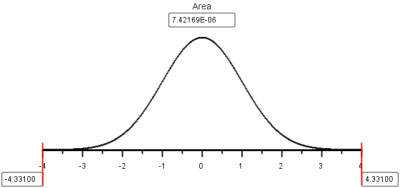
Note that \(P\)-value\(= 0.00000742 < 0.05 = \alpha\), so we reject the null hypothesis.

There is sufficient evidence to suggest that the true proportion of patients who die from an aortic aneurysm is greater on the weekends than on the weekdays. It appears that there are substantial differences in the quality of care available to patients on the weekends compared to patients on weekdays.

Mortality Rates and Day of Admission: Heart Attacks
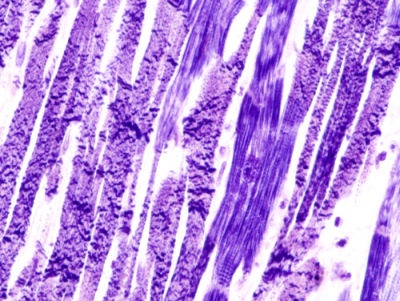
Heart attacks are a leading cause of death in many areas of the world. The study by Doctors Bell and Redelmeier included an analysis of the risk of dying of a heart attack, after admission to a hospital. The researchers reported the following death rates, depending on whether the heart attack occurred on a weekday or a weekend .
| Outcome | Weekday Admission | Weekend Admission |
|---|---|---|
| Died (x) | 17,113 | 6,289 |
| Survived | 100,596 | 36,222 |
| Total (n) | 117,709 | 42,511 |
In this section, you will conduct a hypothesis test to determine if the proportion of patients who die of a heart attack is greater on weekends than on weekdays. Use the 0.05 level of significance.

- Summarize the relevant background information

- Describe the data collection process.

- The value of \(\hat p_1\), the sample proportion of patients who died of a heart attack on a weekday, is \(\hat p_1 = \frac{17113}{117709} = 0.14538\). Find the value of \(\hat p_2\).
- Create a chart illustrating the data.
- Based on your answers to questions 7 and 8, does it appear that the risk of dying is greater if a heart attack occurs on a weekend than on a weekday?
- If the proportion of patients who die of a heart attack is greater on weekends than on weekdays, which of the following would best describe the relationship?
- A. \(p_1 = p_2\)
- B. \(p_1 > p_2\)
- C. \(p_1 < p_2\)
- D. \(p_1 \ne p_2\)

- Replace the circles (\(\bigcirc\)) in the following null and alternative hypotheses with two of the following symbols: \(=><\ne\).
\[ \begin{array}{rl} H_0: & p_1 \bigcirc p_2 \\ H_a: & p_1 \bigcirc p_2 \end{array} \]
Show/Hide Solution- What are the requirements for this test?
- Are the requirements for this hypothesis test satisfied? Justify your answer.
- Write the equation for the test statistic, \(z\).
- Compute the value of the test statistic.
- Present a sketch of the sampling distribution, showing the test statistic and the \(P\)-value.
- Find the \(P\)-value.
- Compare the \(P\)-value to the level of significance. Which is smaller? Will you reject, or fail to reject, the null hypothesis?
- What is your decision?
- Fill in the blanks in the following sentence:
- There is \(\text{____________}\) evidence to suggest that the true proportion of patients who die of a heart attack is \(\text{__________}\) on weekends than on weekdays.*

- If you were to have a heart attack, would you be more concerned if it occurred on a weekend than on a weekday?

Confidence Intervals: Managing Fox Populations
During the mid 1800’s, European foxes were introduced to the Australian mainland. These predators have been responsible for the reduction or extinction of several species of native wildlife.

The Royal Botanic Gardens Cranbourne is a 914 acre (370 ha) conservation reserve outside Melbourne, Australia. Predation by foxes has been an ongoing problem in the gardens. To reduce the risk to native species, a systematic program of killing foxes was implemented.
One way to monitor the presence of foxes is to look for fox tracks in specific sandy areas, called sand-pads. Before beginning a systematic effort to reduce the fox population, ecologists observed fox tracks in the sand-pads 576 out of the 950 times the sand-pads were observed. After eliminating some of the foxes, the ecologists observed fox tracks in the sand-pads 268 times out of the 1359 times they checked the sand-pads . The ecologists want to know if there is a difference in the proportion of times fox tracks are observed before versus after the intervention to reduce the fox population.
One way to compare two proportions is to make a confidence interval for the difference in the proportions.
The equation for the confidence interval for the difference of two proportions may look a little daunting at first, but with some practice, it is not too difficult.
Before we compute the confidence interval, we first organize our data and calculate some statistics that will be useful later. We divide the data into two groups: before foxes were targeted (Group 1) and after (Group 2). For each group, let \(x_1\) and \(x_2\) represent the number of times fox prints were observed in the sand-pads before and after the ecologists began systematically eliminating the foxes, respectively. Similarly, Let \(n_1\) and \(n_2\) be the number of times the ecologists checked the sand-pads in the before and after periods, respectively.
Fox Tracks Data
| Before Intervention | After Intervention | Combined Data | |
|---|---|---|---|
| Fox Tracks Observed | \(x_1 = 576\) | \(x_2 = 268\) | \(x_1 + x_2 = 576 + 268 = 844\) |
| Total Observations | \(n_1 = 950\) | \(n_2 = 1359\) | \(n_1 + n_2 = 950 + 1359 = 2309\) |
Similar to what we did in the lesson for Lesson 17: Inference for One Proportion, we compute \(\hat p\) for each group.
For group 1: \[ \hat p_1 = \frac{x_1}{n_1} = \frac{576}{950} \]
For group 2: \[ \hat p_2 = \frac{x_2}{n_2} = \frac{268}{1359} \]
An equation of the confidence interval for the difference between two proportions is computed by combining all the information above: \[ \left( \left( \hat p_1 -\hat p_2 \right) - z^* \sqrt{ \frac{\hat p_1 \left( 1 - \hat p_1 \right)}{n_1} + \frac{\hat p_2 \left( 1 - \hat p_2 \right)}{n_2} } , ~ \left( \hat p_1 -\hat p_2 \right) + z^* \sqrt{ \frac{\hat p_1 \left( 1 - \hat p_1 \right)}{n_1} + \frac{\hat p_2 \left( 1 - \hat p_2 \right)}{n_2} } \right) \]
If you need to review how to find the value of \(z^*\) for other confidence levels, see page Lesson 10: Inference for One Mean: Sigma Known (Confidence Interval).
The lower bound for a 95% confidence interval for the difference of the proportions of times fox prints are observed in the sand-pads is:
\[ \displaystyle{ \left( \hat p_1 -\hat p_2 \right) - z^* \sqrt{ \frac{\hat p_1 \left( 1 - \hat p_1 \right)}{n_1} + \frac{\hat p_2 \left( 1 - \hat p_2 \right)}{n_2} } } \]
\[ \displaystyle{ = \left( \frac{576}{950} - \frac{268}{1359} \right) - 1.96 \sqrt{ \frac{\frac{576}{950} \left( 1 - \frac{576}{950} \right)}{950} + \frac{\frac{268}{1359} \left( 1 - \frac{268}{1359} \right)}{1359} } } \]
\[ \displaystyle{ = 0.372 } \]
and the upper bound is:
\[ \displaystyle{ \left( \hat p_1 -\hat p_2 \right) + z^* \sqrt{ \frac{\hat p_1 \left( 1 - \hat p_1 \right)}{n_1} + \frac{\hat p_2 \left( 1 - \hat p_2 \right)}{n_2} } } \]
\[ \displaystyle{ = \left( \frac{576}{950} - \frac{268}{1359} \right) + 1.96 \sqrt{ \frac{\frac{576}{950} \left( 1 - \frac{576}{950} \right)}{950} + \frac{\frac{268}{1359} \left( 1 - \frac{268}{1359} \right)}{1359} } } \]
\[ \displaystyle{ = 0.447 } \]
Make sure you can compute these confidence intervals before reading on.
So, the 95% confidence interval for the difference in the proportions is:
\[ (0.372, 0.447) \]
If we switch the way we label group 1 and group 2, then our confidence interval would have the opposite signs: \((-0.447, -0.372)\).
To interpret this confidence interval, we say, “We are 95% confident that the true difference in the proportions of times fox prints will appear in the sand-pads is between 0.372 and 0.447.”
Notice that zero is not in this confidence interval, so zero is not a plausible value for \(p_1 - p_2\). Based on this result, it is reasonable to conclude that the proportion of times foxes are observed in the sand-pads is not the same before and after the effort to reduce their population. It seems that the work to reduce the number of foxes is having an effect on their presence in the reserve.
As you may have guessed, the Math 221 Statistics Toolbox can be used to calculate confidence intervals for the difference of two proportions.
Checking Requirements for a Confidence Interval
The requirements for computing a confidence interval for two proportions are the same as the requirements for doing a hypothesis test.
\[ \begin{array}{rrr} n_1 \cdot \hat p_1 \ge 10 && n_2 \cdot \hat p_2 \ge 10 \\ n_1 \cdot \left(1-\hat p_1\right) \ge 10 && n_2 \cdot \left(1-\hat p_2\right) \ge 10 \end{array} \]
In this example, all of the requirements are satisfied:
\[ \begin{array}{rr} n_1 \cdot \hat p_1 = 950 \cdot 0.606 = 576 \ge 10 & n_2 \cdot \hat p_2 = 1359 \cdot 0.197 = 268 \ge 10 \\ n_1 \cdot \left(1-\hat p_1\right) = 950 \cdot (1-0.606) = 374 \ge 10 & n_2 \cdot \left(1-\hat p_2\right) = 1359 \cdot (1-0.197) = 1091 \ge 10 \end{array} \]
- What is the value of \(z^*\) for a 93% confidence interval?
- Find the 93% confidence interval for the difference in the proprotions of the times fox prints are observed in the sand-pads before and after the effort to reduce the fox population.
Summary
When conducting hypothesis tests using two proportions, the null hypothesis is always \(p_1=p_2\), indicating that there is no difference between the two proportions. The alternative hypothesis can be left-tailed (\(<\)), right-tailed(\(>\)), or two-tailed(\(\ne\)).
For a hypothesis test and confidence interval of two proportions, we use the following symbols: \[ \begin{array}{lcl} \text{Sample proportion for group 1:} & \hat p_1 = \displaystyle{\frac{x_1}{n_1}} \\ \text{Sample proportion for group 2:} & \hat p_2 = \displaystyle{\frac{x_2}{n_2}} \end{array} \]
For a hypothesis test only, we use the following symbols:
\[ \begin{array}{lcl} \text{Overall sample proportion:} & \hat p = \displaystyle{\frac{x_1+x_2}{n_1+n_2}} \end{array} \]
Whenever zero is contained in the confidence interval of the difference of the true proportions we conclude that there is no significant difference between the two proportions.
You will use the Excel spreadsheet Math 221 Statistics Toolbox to perform hypothesis testing and calculate confidence intervals for problems involving two proportions.
Copyright © 2020 Brigham Young University-Idaho. All rights reserved.
